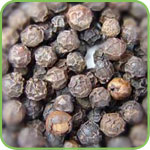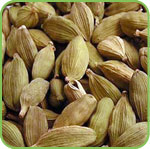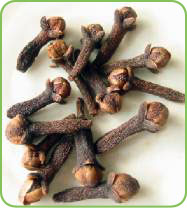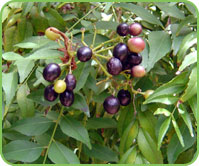|
|
|
Spices of Kerala |
|
|
The story of
Kerala's spices dates back to many thousands of years into the
past. Kerala is famous in the world due to total monopoly over
spices. The ancient port of Musiris was the centre of the
spice trade years ago. Vasco Da Gama's arrival was just the
culmination of the western world's rush to find the sea route
to the West Indies and its spices trade. Within the last
decade the international trade in spices has grown to an
estimated 500,000 ton of spices and herbs valued at more
than 1500 million US dollars. It is a matter of pride for the
tiny state of Kerala that the bulk of this trade is still from
Kerala. Some spices that have made Kerala a spice state are as
follows: |
|
|
|
Pepper
The pepper is rightly known as the 'King Of Spices' and
is one of the best known spices in the world. Kerala is
the major producer and exporter of this most exotic
spice. Pepper is one of the earliest and one of the most
widely used spice in the world today. Kerala's pepper
reached Europe through Arab traders who held a monopoly
over its trade. Europe in the middle ages saw the
enormous potential of pepper as a food preservative and
eagerly sought to control its trade. The pepper is the
finest in quality and is grown along the lowlands and
high ranges of Kerala. It requires 20 to 30 degree
Celsius temperature and is propagated by stem cutting.
The Malabar Garbled, |
 |
|
|
Panniyur-1,
Karimunda, Kuthiravally, Arakkulam Munda, Balankotta,
Kalluvally and Tellichery Extra Bold are some of the famous
varieties of pepper. Pepper is a perennial climber requiring
the support of live or dead trees. It has a limited usage in
medicine as a carminative and as a stimulant of gastric
secretions. The pepper plant grows best in a warm and humid
climate. Berries mature and are ready for harvest in about 180
to 200 days. Black pepper is produced by sun drying the mature
pepper berries for 3-5 day after they are separated from
spikes by threshing and white pepper by retting mature berries
in clean water for 5-7 days, removing the outer skin and
drying the seed after through washing. A combination of
natural advantages and organic techniques produces bigger,
better-shaped, more aromatic and flavored pepper, better than
anywhere else in the world. |
|
|
|
Cardamom
Cardamom is one of the most highly prized spices. The
best known cardamom variety is from India. It is
obtained from a ginger-like plant, Elettaria cardamomum.
Cardamom belongs to the ginger family and is the most
expensive spice in the world after saffron and vanilla.
It is known in India as Queen of Spices. It's history is
as old as human civilization. Cardamom use spread to
Europe more than a thousand years ago. The Vikings
introduced it to Scandinavia, and Europe has been hooked
ever since. Cardamom is the dried fruit of a herbaceous
perennial and mainly grown in Kerala, Tamil Nadu and
Karnataka, on the slopes of the Western Ghats, at an
altitude of 1500 m above sea level. Warm humid climate,
loamy soil rich in organic matter, |
 |
|
|
distributed
rainfall and special cultivation and processing methods all
combine to make Indian Cardamom truly unique in aroma, flavour,
size and colour. Alleppey Green Extra Bold (AGEB), Alleppey
Green Bold (AGB) and Alleppey Green Superior (AGS) are some of
the famous varieties of Cardamon. A cardamom plant is grown by
its seedlings. It normally starts bearing capsules from the
third year of planting. The harvesting is done from October to
February. The harvested capsules are rubbed on wire mesh and
polished before they are graded and stored in polythene-gunny
bags to retain the green color and to avoid exposure to
moisture. The true cardamom has large leaves and white flowers
with blue stripes and yellow borders. It grows to about 3 m
(about 10 ft) in height. The fruit is a small capsule with 8
to 16 brown seeds and these seeds are used as a spice.
Cardamom has a warm and eucalyptus-like flavor with a hint of
lemon. The aromatic extract contains many essential oil
chemicals, some of which have a smell like that of camphor.
The people of Arabia and Africa welcome their guests with
cardamom-flavored coffee, and Ethiopians have elaborate
cardamom-coffee ceremonies. It is used as an adjunctive spice
in curries, coffees and other Asian or Middle Eastern foods,
in baked products in Scandinavian and Baltic countries. The
seeds are widely used in cooking and in chewing products in
India and Pakistan, and in Persian cuisine. It is also used as
a perfume and breath freshener. Cardamom is a common folk
remedy for indigestion in many cultures. Other traditional
uses for the spice include cures for bronchitis, sinusitis,
fever, sore throat, and liver ailments. |
|
|
|
Vanilla
Natural vanillin is obtained from the cured pods
(fruits) of the vanilla plant Vanilla planifolia.
Vanilla is a perennial climbing orchid with sessile
leaves and succulent green stems, producing aerial roots
(velamen roots) at the nodes. Vanilla is a native of
Mexico and was introduced in India in 1835. In India,
parts of Kerala, Karnataka and Tamil Nadu, north eastern
region and Andaman and Nicobar islands are suitable for
vanilla cultivation. Karnataka has the largest area
under vanilla in the country. There are three important
cultivated species of vanilla namely, Vanilla planifolia,
V.Pompona, and V.Tahitensis. Vanilla is adapted to a
wide range of soil types rich in humus and have good
drainage. It thrives well in humid tropical climate with
an annual rainfall of 1500-3000 mm at 1500 m above sea
level. A warm humid climate, with temperature ranging
from 21 to 32 Degree Celsius is ideal for the plant.
Vanilla grows best in unclear jungle areas where it
|
 |
|
|
gets filtered
sunlight. The rainfall should be well distributed for a period
of 9 months and there should be a dry period of 3
months for flowering. The bean takes 10 to 12 months to reach
full maturity. The plant requires support upto a height of
about 135 cm. Vanilla is usually propagated by stem cutting.
Cuttings of 60-120 cm long can be selected as planting
material for direct planting in the field. Cuttings less than
60 cm should not be used directly for planting. Such cuttings
have to be rooted and raised in the nursery before planting.
The stem cuttings after collection should be washed thoroughly
and dipped in Bordeaux mixture 1% or copper oxychloride 0.2%
for killing pathogenic fungi, if any. Then the cuttings are
stored in cool shaded place for 2-3 days for partial loss of
moisture, a process which enhances rooting. The cuttings can
also be stored up to 10 days if required. Plants raised from
mature lengthy cuttings flower early. Tissue cultured
plantlets can also be utilized for planting. However,
sufficiently grown up plantlets should be used. The rostellum
of the flower is pushed back with a pointed bamboo splinter
and the overhanging anther is pressed against the stigma with
the thumb, thus smearing pollen over it. The ideal time for
pollination is 0600 to 1300 hrs. |
|
|
|
Clove
Clove is a small, reddish-brown flower bud of the
tropical evergreen tree Syzygium aromaticum (Eugenia
caryophyllata) of the Myrtaceae family. The cloves were
very important in the earliest spice trade. Clove was
first introduced to India around 1800 AD by the East
India company in its 'spice garden' in Courtallam, Tamil
Nadu. Induced by the success of its introduction,
cultivation of clove was extended during the period
after 1850 AD to Nilgiris, southern region of the
erstwhile Travancore state and the slopes of Western
Ghats. The important clove growing districts in India
are Nilgiris, Tiruneiveli, Kanyakumari, Nagercoil and
Ramanathapuram districts of Tamil Nadu, Kozhikode,
Kottayam, Kollam and Thiruvananthapuram districts of
Kerala and South Kanara district of Karnataka. Cloves
vary in length from about 1/2 to 3/4 inch (13 to 19 mm |
 |
|
|
). They
contain 14 to 20 percent essential oil. The principal
component of which is the aromatic oil Eugenol. Cloves are
strongly pungent owing to Eugenol, which is extracted by
distillation to yield oil of cloves. This oil is used to
prepare microscopic slides for viewing and also as a local
anaesthesia for toothaches. Eugenol is used in germicides,
perfumes, and mouthwashes, in the synthesis of vanillin, and
as a sweetener or intensifier. Clove is propagated through
seed obtained from ripened fruit, known, popularly as 'mother
of clove'. Fruits are taken from trees with more then 15 years
of age and regular yielding nature. The ripened seeds has to
drop down naturally. Such fruits are picked and sown directly
in the nursery. Otherwise, fruits are soaked in water
overnight and the seeds are obtained after removal of the
pericarp are sown. Only fully developed and uniform sized
seeds which show signs of germination by the presence of pink
radicle are ideal for sowing. Heaping the fruits for one or
two days or keeping them in airtight bags leads to the death
of seeds. The Clove trees begin to bear flowers 7-8 years
after planting. Unopened flower buds are carefully picked when
they turn from green to pink. The buds are then allowed to dry
for 4-5 days till they become crisp and dark brown in color.
It's aroma is very strong and is very hot and pungent in
taste. Cloves is used to flavor many foods, particularly
meats and bakery products. Cloves are an essential ingredient
of Kerala cuisine.
|
|
|
|
Cinnamon
Cinnamon is the dried inner stem bark of Cinnamomum
Verum tree. This bushy evergreen tree is about 10-15 m
tall, belonging to the family Lauraceae. It is widely
grown in Kerala and other tropical regions of the world
including Sri Lanka. The bark is widely used as a spice.
The leaves are ovate-oblong in shape, 7-18 cm long. They
are leathery and shining green on upper surface when
mature. The flowers have a greenish color and a rather
disagreeable odour. The fruit is a dark purple seeded
berry containing a single seed. The spice is light brown
in color and has a delicately fragrant aroma and warm,
sweet flavor. It is lighter in color and milder in
flavor than the other |
 |
|
|
species.
Cinnamon was once more valuable than gold and has been
associated with ancient rituals of sacrifice or pleasure.
Cinnamon is a hardy plant and cultivated under varying
conditions ranging from semi dried to wet zone conditions. It
prefers shelter and moderate rainfall. The ideal temperature
for growing Cinnamon is between 20-30 degree Celsius and
rainfall between 1250 to 2500 mm. They are cultivated as low
bushes to ease the harvesting process. Eight to ten lateral
branches grow on each bush and after three years they are
harvested. Cinnamon plants are ready for harvest in about 3
years after planting. Harvesting is done twice a year in May
and November. The bark of the cut down shoot is split on the
day of harvest itself and dried in the sun for 2-5 days.
Cinnamon bark is a popular spice with a delicate fragrance and
a warm taste. The brown colored bark is easily chewable. It is
used in the form of small pieces or powder. It gives a dish a
very rich flavor. Cinnamon is an essential ingredient of the
Kerala cuisine. It is used to flavor a variety of foods, from
confections to curries. The stick cinnamon is added whole to
rice dishes, mulled wines, punches, and syrups for poaching
fruit. The chips are also used in tea infusions or spiced
cider blends. Ground cinnamon is used in baked goods like
cakes, pastries and biscuits. Cinnamon leaf oil is used in
processed meats, condiments and also in bakery items. It is
also used in the preparation of desserts, chocolate, spicy
candies and liquors. In the Middle East, it is often used in
savory dishes of chicken and lamb. In America, cinnamon and
sugar are often used to flavor cereals and fruits, especially
apples. It is also used in pickling. Cinnamon leaf and bark
oil are obtained by distilling the leaf and bark separately.
The cinnamon bark oil has anti-fungal properties and cinnamon
leaf oil is widely used in perfumes and cosmetics. It is also
used in flavoring confectionary, liquors and pharmaceuticals.
Cinnamon is a stimulant, astringent and carminative, used as
an antidote for colds, Diarrhoea, nausea, vomiting and other
problems of the digestive system. It is also used by the
diabetic patients in digestion of sugar. |
|
|
|
Nutmeg
Nutmeg is the seed of Myristica fragrans, an evergreen
tree. Interestingly, the tree produces both Nutmeg and
mace, and grows up to 60 feet tall. Although the tree
takes seven years to bear fruit, it may produce until
the 90th year. Both spices come from the tree’s fruit,
which splits into a scarlet outer membrane, mace, and an
inner brown seed, |
 |
|
|
Nutmeg. The
Nutmeg tree bears fruit throughout the year, but peak harvest
season is from December to May. The nuts split open when the
fruits are fully ripe. After dehusking, the red feathery aril
(mace) is removed, flattened out and dried in the sun for
10-15 days. The nuts are dried separately for 4-8 weeks till
the kernels rattle within the shells. Nutmeg is more pungent
and sweeter than mace. But slightly bitter flavor of Nutmeg
adds character to vegetables. Nutmeg is used in whipped cream,
custard, pudding, fruit pies and eggnog. Nutmeg is a mild
baking spice and is used in sausages, meats, soups, and
preserves. Ground Nutmeg is an ideal baking spice and is
especially complimentary in sweet breads, cakes, muffins,
cookies. Mace is often preferred in light-colored dishes for
the bright orange, saffron-like color it imparts. The
essential oil is obtained by the steam distillation of ground
nutmeg and is used heavily in the perfumery and pharmaceutical
industries. The oil is colorless or light yellow and smells
and tastes of nutmeg. It is used as a natural flavor in baked
goods, syrups, beverages, sweets etc. The essential oil is
also used in tooth paste and as major ingredient in some cough
syrups. Nutmeg and nutmeg oil are used for illnesses related
to the nervous and digestive systems. The oil is used in
rheumatic pain, dull toothache, nausea, gastroenteritis,
chronic diarrhea, and indigestion. Nutmeg powder is used as an
ingredient, in small quantities, in the Indian spice mixture
garam masala, which is a mixture of dry spices. It is also
used as a flavoring agent in Indian sweets. |
|
|
|
Ginger
Ginger root is used extensively as a spice in many
cuisines of the world. The active constituent of fresh
ginger is gingerol. When ginger is dried, the gingerol
molecules are converted into the much more pungent
shogaols. Cooking ginger transforms gingerol into
zingerone, which is less pungent and has a spicy-sweet
aroma. The ginger is often pickled in vinegar or just
cooked as an ingredient in many dishes. The juice from
old ginger roots is extremely potent and is often used
as a spice to cover up other strong odours and flavors
such as in seafood and mutton. Ginger is also used
as a flavor in candy, cookies, cookies, biscuits and
cake, and is the main flavor in ginger |
 |
|
|
ale, a sweet,
carbonated, non-alcoholic beverage. It is used in nausea
caused by motion sickness, morning sickness or other illness.
Ginger root also contains many antioxidants. Powdered dried
ginger root is made into pills for medicinal use. Ginger ale
and ginger beer have been recommended as "stomach settlers"
for generations in countries where the beverages are made.
Ginger water was commonly used to avoid heat cramps. |
|
|
|
Turmeric
Turmeric is botanically known as Curcuma longa, derived
from the old Arabic name for the kurkum plant. This
spice is a member of the ginger family. Like ginger, it
is the root of the turmeric plant that is used as a
spice, usually in a dried form. The root is generally
peeled to expose its bright yellow flesh, then boiled,
dried, and ground into a powder. Turmeric is also known
as Indian saffron. Turmeric is extremely pungent, and
actually gets stronger when cooked. Turmeric gives
ball-park yellow mustard bright color. A little goes a
long way, so use it sparingly when experimenting. Avoid
touching your clothing when working with turmeric as it
is a powerful yellow dye. It is an |
 |
|
|
amazing healing
plant that has not only been valued for its therapeutic
properties in Ayurvedic and Chinese medicine for thousands of
years but also used in the prevention and treatment of a wide
range of modern day problems. It is an excellent natural
antibiotic, and one of the best detoxifying herbs due to its
beneficial effect on the liver, cardiovascular, skeletal and
digestive systems. Turmeric has powerful antioxidant
properties and is used in the treatment of various cancers,
respiratory infections such as cold, sore throat, cough and
fever, skin problems such as acne and psoriasis, and kidney
and bladder problems. It can successfully inhibit infection
whether bacterial, viral or fungal. It is an important
ingredient in curry mixes, chutney, and mustard pickles. It
also goes well with chicken, duck, turkey, vegetables, rice,
and salad dressing. Turmeric is used as a prime ingredient in
Worcestershire sauce, and is used to color other foods like
butter, cheese, and fruit drinks. It is a favorite in Middle
East and Asian foods and spice blends such as curry. |
|
|
|
Tamarind
Tamarind is also known as Indian date. Tamarind is the
sweet and sour fruit of a tall shade tree native to Asia
and northern Africa and widely grown in India. The
tamarind trees flourishes in the tropical regions. The
tree grows up to 20 meters in height, and stays
evergreen in regions without a dry season. Tamarind
timber consists of hard, dark red heartwood and softer,
yellowish sapwood. The leaves consist of 10 to 40
leaflets. The flowers are produced in racemes. The tree
produces brown pod-like fruits, which contain pulp and
many hard-coated seeds. |
 |
|
|
The large
(about 5-inch-long) pods contain small seeds and a sour-sweet
pulp that, when dried, becomes extremely sour. The
harvesting season of tamarind is mainly during March and
April. Tamarind brings an acidic zing to food. The dried
tamarind is obtained after removing the rind from the mature,
ripe and dried fruit of Tamarindus Indica. It is then
compressed into cakes. This spice also comes in the forms of
pulp and juice concentrates which mainly go into the
preparation of cool drinks, sea foods and a range of
sophisticated cuisine. The pulp of a young fruit is very sour,
and hence suitable for main dishes, whereas a ripened fruit is
sweeter and can be used in desserts, drinks, or as a snack.
Its taste goes well with meat and vegetable dishes, it merges
well with the heat of chilies and gives South Indian dishes
their hot and sour character and their dark color. The Juice
of dry Tamarind are adequate to add a touch of sourness in the
curry. It is extensively used in south Indian cuisine and is
normally used as a replacement for tomatoes. Tamarind is also
very effective as a natural preservative and marinade.
Tamarind is a multi-purpose herb. Almost all parts of it can
be used; beans, seeds, pulp, leaves, flowers, juice and bark.
It is used as a digestive, laxative, tonic, and astringent. It
is favored for wound treatment, sore throat, urinary problems,
gonorrhea, ulcers, liver disease. Tamarind is acidic and
excites the bile and other juices in the body. Tamarind is
also a blood purifier. Folk medicine uses Tamarind leaves for
sprains and swelling. Due to its denseness and durability,
tamarind heartwood can be used in making furniture and wood
flooring. The wood is a beautiful red timber. Tamarind is also
recommended as a polish for brass and copper. |
|
|
|
Curry
Leaves
The leaves of curry leaf tree is a spice. The curry tree
is five meter in height, 15-40 cm in diameter. It is
cultivated mainly in homesteads but to a certain extent
on a plantation scale. The curry leaf tree is a
fast-growing shrub with deep roots and scented leaves
and is an important ingredient in curries in South
India, Sri Lanka and North India. Together with various
South Indian dishes, curry leaves have also reached
outside the India. Fresh curry leaves are oval in shape
and about 1 inch in length. The curry leaves have a
pungent and bitter smell much like the leaves of a
citrus tree. The curry leaf is mainly a |
 |
|
|
culinary plant
and cultivated for its aromatic leaves and as an ornamental
plant throughout South India. The plant is grown in almost
every home garden in South India. All it needs is some water
during a dry spell and some sunshine during cold months. It
can withstand a small amount of frost and needs moderate light
and warmth to grow. A small pot with these aromatic leaves can
be kept in a partially indoor area, to remove insects, as well
as ensure a fresh aroma to the area. Planting is mostly done
just before the arrival of the monsoon in May. It is
propagated by seeds, which germinate freely under partial
shade. The leaves can be harvested about 15 months after
planting, and a fully grown tree can yield about 100 kg leaves
each year. Curry leaves should not be removed from the
branches as leaves are highly
aromatic and are used as a herb or spice. They are mainly used
fresh, but are also used dried or powdered. For some recipes,
the leaves are oven-dried or toasted immediately before use.
They are extensively used in Southern India as a natural
flavoring agent in various vegetarian dishes. Curry Leaves
are typically fried until brown, then cooked with the dish.
Because of their soft texture, they are never removed before
serving, but can be eaten without any hazard. The curry leaves
can also be used on skin and as an effective hair colorant.
The leaves, bark and root of the plant are also used in
various medicinal applications. It is an essential ingredient
in almost all traditional medicine systems of India, including Ayurveda. It is used to cure ailments like piles,
constipation, nausea, diarrhoea, leucoderma, blood disorders,
skin irritations and poisonous bites. The wood of the curry
leaf tree is greyish-white, hard, close-grained and durable.
It is used to make agricultural tools. Curry leaves are steam
distilled to produce an oil which is used in the production of
soap. Its oils are used as repellants and to cure skin
disorders. |
|



